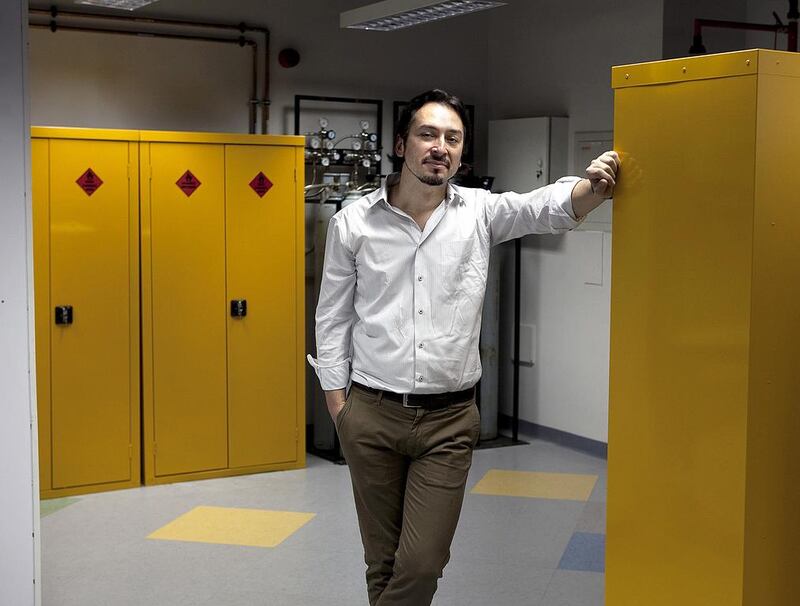The rush of energy at the start of a race, when the athletes burst out of the starting blocks and tear along the track, is impressive to behold.
The blur of running shoes, limbs and torsos is made possible by muscles converting chemical energy into mechanical energy.
It is a process fundamental to all of our activities, and as such it is as well-understood by scientists as it can be exciting to watch.
At New York University Abu Dhabi, a team of researchers is analysing ways in which changes from one form of energy to another take place, but at a very different scale to what we observe at a sports event.
The group, headed by Dr Pance Naumov, is studying energy conversion at the molecular level. They are particularly interested in what are described as non-conventional types of energy transformation.
These can include ways chemical energy is transformed into light, or methods of converting light or heat into mechanical work.
Their work could eventually help develop new ways to synthesise drugs without the large amounts of harmful waste that can be generated through traditional methods. Not only that, it could help scientists come up with better ways of diagnosing cancer.
Among Dr Naumov’s achievements before he moved to NYU Abu Dhabi was working out the structure of an unstable molecule called oxyluciferin, which enables creatures such as fireflies to emit light as it reverts to its more stable form, known simply as luciferin. This is a natural example of how chemical energy is converted into light energy.
His team is studying what are known as smart materials, including crystals that move when exposed to heat and light.
They have produced a special hybrid material made of tiny crystals dispersed in a film of a polymer – a substance made from repeated subunits, like most plastics – made from casein, a protein found in milk.
The results have been quite dramatic, with motion created when the hybrid combines the rapid energy transfer created by the crystals with the polymer matrix’s elastic and reinforcing properties. It is, said Dr Naumov, “similar to the interplay between a bone and flesh in a muscle”.
“The crystals can absorb light and heat, and in effect they deform to actuate the polymer, which brings about a readily observable motion,” he said.
Such “biomimetic” materials, named for their ability to mimic nature, can be used to produce artificial muscles, just as has been the case with similar “electroactive” polymers, which are stimulated by an electric current.
Many of the processes Dr Naumov works on are artificial versions of phenomena already seen in nature, whether they involve the production of motion or light.
Artificial muscles have myriad potential applications, among them creating motion in medical devices. Other researchers have also produced heat-sensitive blinds that open or close depending upon how hot it is in a room.
Dr Naumov said his work could find application in the field of microfluidics, which deals with controlling the movement of fluids at a tiny scale such as with inkjet printing.
Another strand of Dr Naumov’s research, carried out in collaboration with researchers in France and Germany, centres on bioluminescence – light produced by the reaction of two or more chemical compounds, without generating heat.
“This reaction has enormous potential for bioanalytical applications, such as microscopic imaging for the diagnosis of cancer and other diseases,” he said.
To make these tests and develop new ones, it is important to understand the mechanisms behind these reactions. The work of Dr Naumov’s team to control the colour and intensity of emitted light is key to this.
“It will eventually enhance the performance by pushing further the detection limits with these techniques,” he said.
Another attention-getter is the potential use of sunlight in helping to synthesise drugs. Just as the UAE has invested heavily in the production of electricity with solar power, Dr Naumov’s work at NYU Abu Dhabi could make the country a leader in the use of sunlight in pharmaceutical manufacturing.
It is a field he describes as “green chemistry” because many of the environmental downsides of traditional methods of synthesising drugs, in which the reactions take place in liquids, are eliminated when solids are used instead.
“Instead of solutions, the chemical reactions will be performed in the solid state, without the use of costly and harmful solvents, and by using sunlight as the initiator and driving force,” said Dr Naumov.
Molecules are distributed randomly in a solution, which means to produce large quantities of a substance the reaction must be carried out over a long time with the use of heat.
Afterwards, byproducts and the solvent in which the reaction took place must be removed, which often requires electricity, increasing costs.
“Some fine chemicals such as pharmaceuticals are synthesised through dozens of chemical reactions, which adds to the final cost and results in a large amount of non-reusable organic solvent waste,” said Dr Naumov.
When they are in the solid state, molecules are, by contrast, “perfectly ordered”, and that means the chemical reaction can be controlled more precisely. Yields are usually very high and harmful solvents are not involved.
“Greening pharmaceutical production is an important step towards a sustainable society, particularly considering the potential that a country with high solar radiation such as the UAE holds in this respect,” he said.






